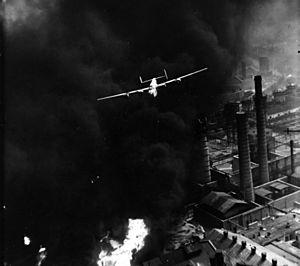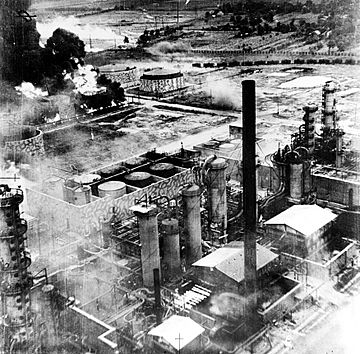Oil campaign of World War II facts for kids
Quick facts for kids Oil campaign |
|||||||
|---|---|---|---|---|---|---|---|
| Part of the Strategic Bombing Campaign in Europe during World War II |
|||||||
 The Sandman, a B-24 Liberator, emerges from smoke over the Astra Română refinery, Ploiești, during Operation "Tidal Wave" (1 August 1943).
|
|||||||
|
|||||||
| Belligerents | |||||||
|
|
|||||||
| Commanders and leaders | |||||||
|
Carl Krauch Ion Antonescu Paul Pleiger |
||||||
| Strength | |||||||
|
See Defence of the Reich | ||||||
| Casualties and losses | |||||||
|
|||||||
The oil campaign of World War II was a major effort by the Allied forces (mainly the RAF from Britain and the USAAF from the US). Their goal was to destroy the places that supplied Nazi Germany with oil and fuel. Oil was super important because it powered Germany's tanks, planes, and ships during World War II.
This campaign was a big part of the larger strategic bombing effort during the war. Allied bombers targeted oil refineries, factories that made synthetic fuel (fake oil), and storage places across Germany and other Axis-controlled countries in Europe.
Britain knew before the war that Germany relied heavily on oil. So, the RAF started bombing Germany in 1940. When the US joined the war in December 1941, they began daytime "precision bombing" attacks. A famous example was Operation Tidal Wave in 1943, which targeted oil refineries in Romania. The last big raid of the war in Europe hit a refinery in Norway in April 1945. The focus on oil targets changed throughout the war, sometimes shifting to other important goals like stopping German V-weapon attacks or preparing for the invasion of western Europe in 1944.
Oil was so important in World War II that other campaigns also focused on getting or stopping oil supplies:
- The Anglo-Soviet invasion of Iran in 1941 helped secure oil from Persia for the Allies.
- Japan attacked the Dutch East Indies (1941–1942) to get oil and rubber after their supplies were cut off.
- Germany's army, the Wehrmacht, tried to reach the oilfields near Baku in the Caucasus region in 1942.
- The Soviet invasion of Romania in 1944 took away the important Ploesti oilfields from the Axis.
Contents
Why Oil Was a Key Target
Before the war, British planners realized how important fuel was to Germany's military. They even had a plan called "Western Air Plan 5(c)" that highlighted this. In 1940, the British Air Ministry kept changing what the RAF should bomb. At one point, oil targets were the top priority for night bombing.
By February 1941, the British Air Staff believed that if RAF Bomber Command destroyed half of 17 key oil targets, Germany's oil production would drop by 80%. This showed how much they thought oil was a "vital centre" for the enemy.
Attacks on Ploiești Oilfields
Even though early bombing wasn't always accurate, Air Chief Marshal Arthur Harris stressed the importance of oil targets at the Casablanca Conference. The first US bombing of a European target was against the Ploieşti refineries in Romania on June 12, 1942. The oil campaign continued, but sometimes other targets took priority. For example, attacks on German V-weapon sites in France (called "Operation Crossbow") or attacks on transport routes before the invasion of France (the "Transportation Plan") became more urgent.

In March 1944, a new plan was made to finish the Combined Bomber Offensive. This plan suggested attacking 14 synthetic fuel plants and 13 refineries in Nazi Germany. Experts thought this could cut Axis oil production by 50%, which was less than Germany needed. This plan also included other priorities like fighter plane production and rubber.
Trial bombings of oil targets in May 1944 showed how important and vulnerable these facilities were. Information from Ultra intercepts (secret messages) also confirmed this. Because of this, oil targets became the highest priority on September 3, 1944.
In June 1944, Bomber Command estimated it would take 32,000 tons of bombs to destroy 10 oil targets in the Ruhr region. Harris agreed to use extra bombing efforts on oil. These targets were so important that one raid even used only bomb-carrying fighter planes to surprise the defenders and give bomber crews a rest.
By late summer 1944, the Allies started using reconnaissance photos to time their bombings. They would hit a plant right when it was starting to produce again. This allowed them to repeatedly damage a plant's power, gas, and water systems. However, bad weather in the fall and winter meant more bombs were dropped on transport targets than oil targets. The benzol (oil) plant in Linz, Austria, was bombed on October 16, 1944. In January 1945, the priority for oil targets was lowered again.
To stop oil from Romania reaching Germany, the RAF also dropped mines into the Danube River.
What Happened After the War
After the war, even though he had sometimes disagreed with making oil targets the top priority, Arthur Harris admitted the oil campaign was "a complete success." He said it was like betting on an underdog that ended up winning the race.
A US directive (JCS 1067) stopped Germany from producing oil until July 1947. The US Army also planned to fix and use some oil facilities if needed. After experts studied German oil plants, the United States Bureau of Mines even hired some German synthetic fuel scientists to work in a chemical plant in the US.
How Important Was the Oil Campaign?
By spring 1944, the Allied bombing campaign hadn't really hurt the German economy much. But the oil campaign was the first to cause major damage and interrupt vital production. The US strategic bombing survey (USSBS) called the damage "catastrophic." However, German industry itself wasn't affected as much by oil attacks because it mostly used coal for energy. The USSBS also said that the breakdown of transportation, caused by attacks on transport targets, was probably the biggest reason for the final collapse of the German economy.
Despite this, several important Germans said the oil campaign was crucial to Germany's defeat. Adolf Galland, a top Luftwaffe (German air force) leader, wrote that it was "the most important of the combined factors which brought about the collapse of Germany." Hermann Göring, the head of the Luftwaffe, called it "the utmost in deadliness."
Albert Speer, who was in charge of German armaments, wrote that it "meant the end of German armaments production." Luftwaffe Field Marshal Erhard Milch said, "The British left us with deep and bleeding wounds, but the Americans stabbed us in the heart," referring to the oil campaign's impact.
Campaign Statistics
Here are some numbers from the British Bombing Survey Unit, showing the oil campaign in the last year of the war.
Number of Attacks
This table shows how many times the RAF and USAAF attacked oil targets:
| Month | USAAF Eighth Air Force |
USAAF Fifteenth Air Force |
RAF Bomber Command |
|---|---|---|---|
| May 1944 | 11 | 10 | 0 |
| June 1944 | 20 | 32 | 10 |
| July 1944 | 9 | 36 | 20 |
| August 1944 | 33 | 23 | 20 |
| September 1944 | 23 | 8 | 14 |
| October 1944 | 18 | 10 | 10 |
| November 1944 | 32 | 19 | 22 |
| December 1944 | 7 | 33 | 15 |
| January 1945 | 17 | 5 | 23 |
| February 1945 | 20 | 20 | 24 |
| March 1945 | 36 | 24 | 33 |
| April 1945 | 7 | 1 | 9 |
| Total | 233 | 221 | 200 |
Tons of Bombs Dropped
This table shows the total weight of bombs (in Short tons) dropped on oil targets:
| Month | USAAF Eighth Air Force |
USAAF Fifteenth Air Force |
RAF Bomber Command |
|---|---|---|---|
| May 1944 | 2,883 | 1,540 | 0 |
| June 1944 | 3,689 | 5,653 | 4,562 |
| July 1944 | 5,379 | 9,313 | 3,829 |
| August 1944 | 7,116 | 3,997 | 1,856 |
| September 1944 | 7,495 | 1,829 | 4,488 |
| October 1944 | 4,462 | 2,515 | 4,088 |
| November 1944 | 15,884 | 4,168 | 16,029 |
| December 1944 | 2,937 | 6,226 | 5,772 |
| January 1945 | 3,537 | 2,023 | 10,114 |
| February 1945 | 1,616 | 4,362 | 15,749 |
| March 1945 | 9,550 | 6,628 | 21,211 |
| April 1945 | 1,949 | 124 | 5,993 |
| Total | 66,497 | 48,378 | 93,691 |
The bombing wasn't always perfectly accurate. German records showed that about 87% of Allied bombs fell outside the factory fences. Only a small percentage actually hit the buildings or equipment inside. The USAAF could hit inside factories 26% of the time in good weather. But this dropped to 5% when they had to rely only on instruments. The RAF hit inside factories about 16% of the time. Both the RAF and USAAF dropped many bombs on oil targets that didn't explode: 19% for the RAF and 12% for the USAAF.
See also

